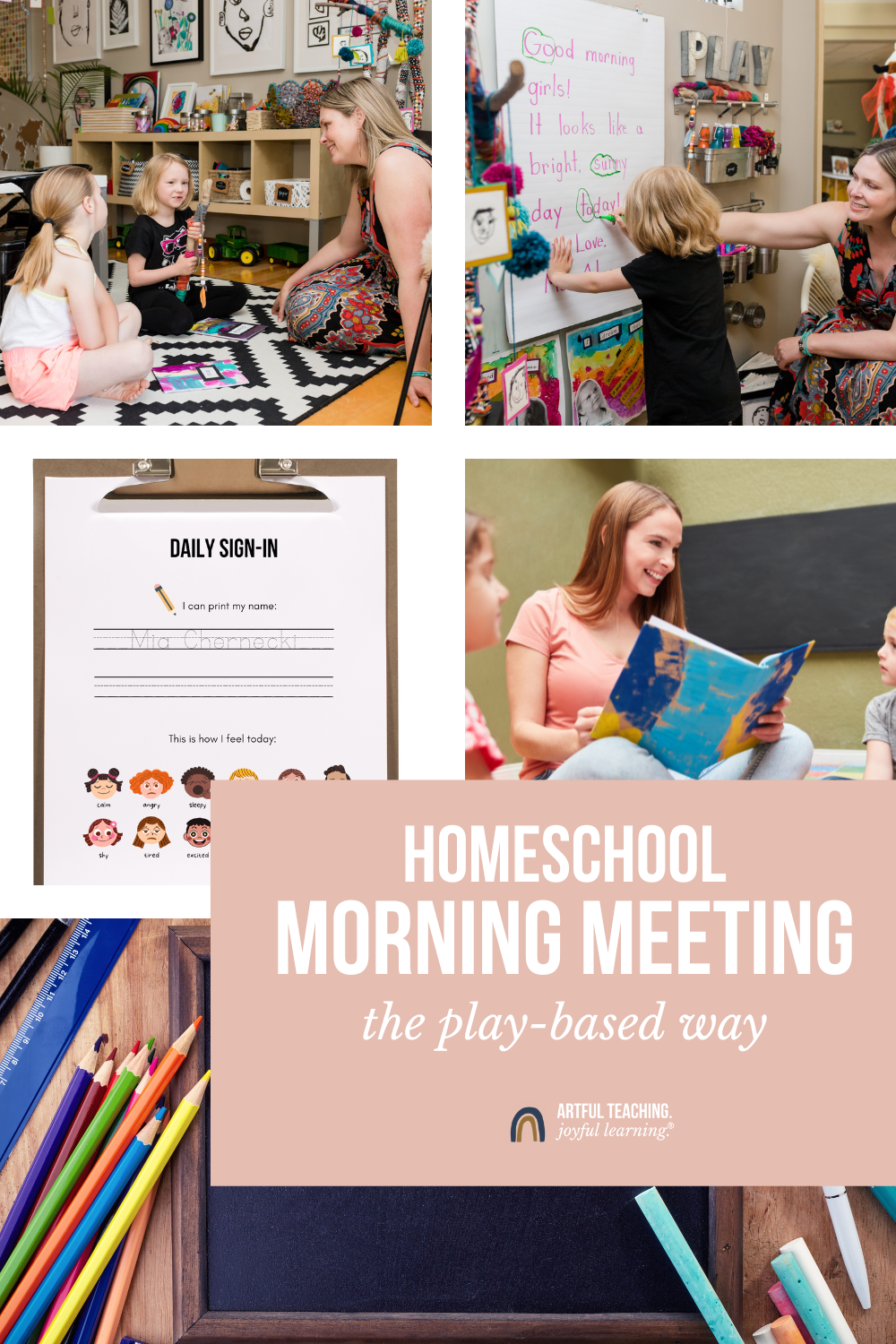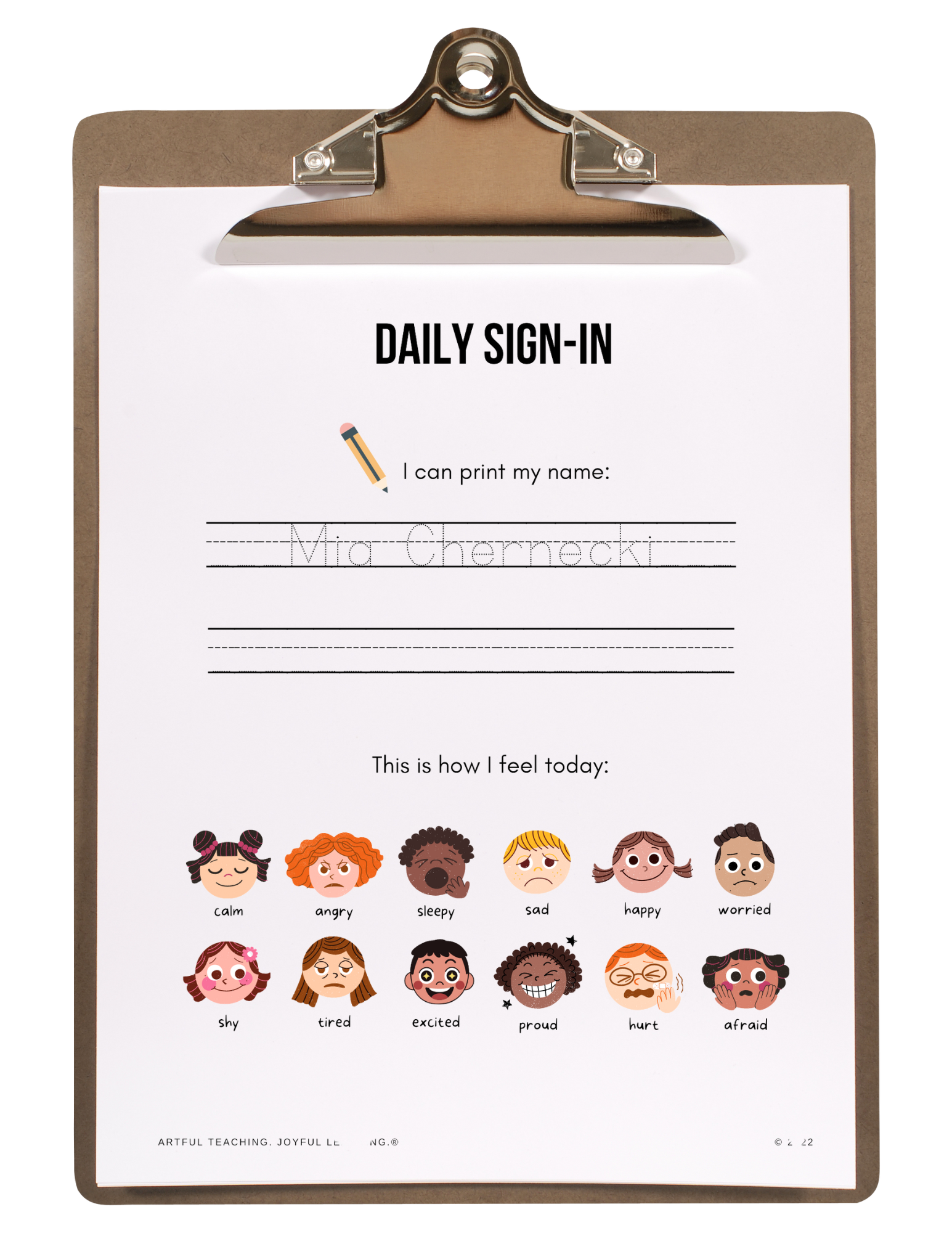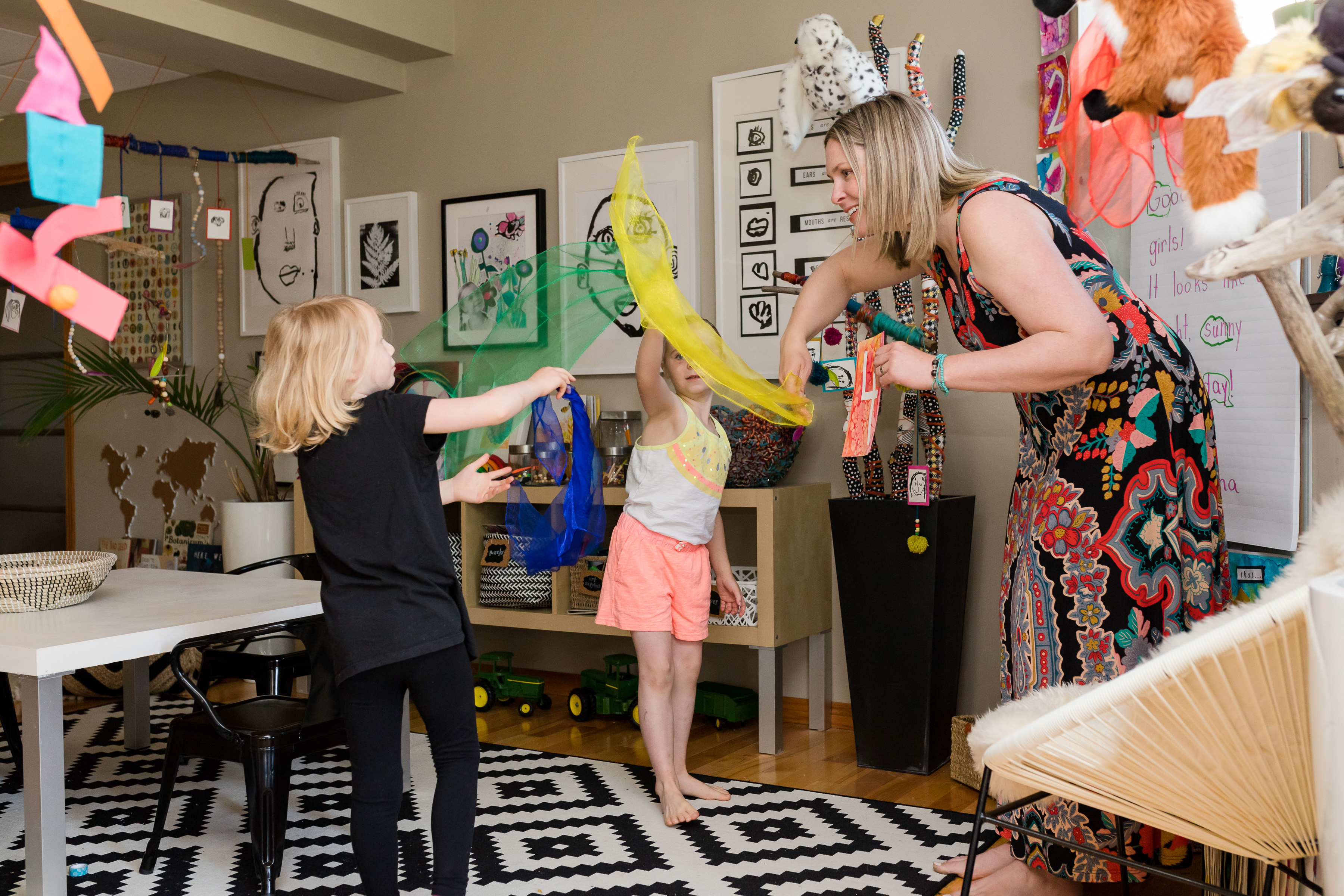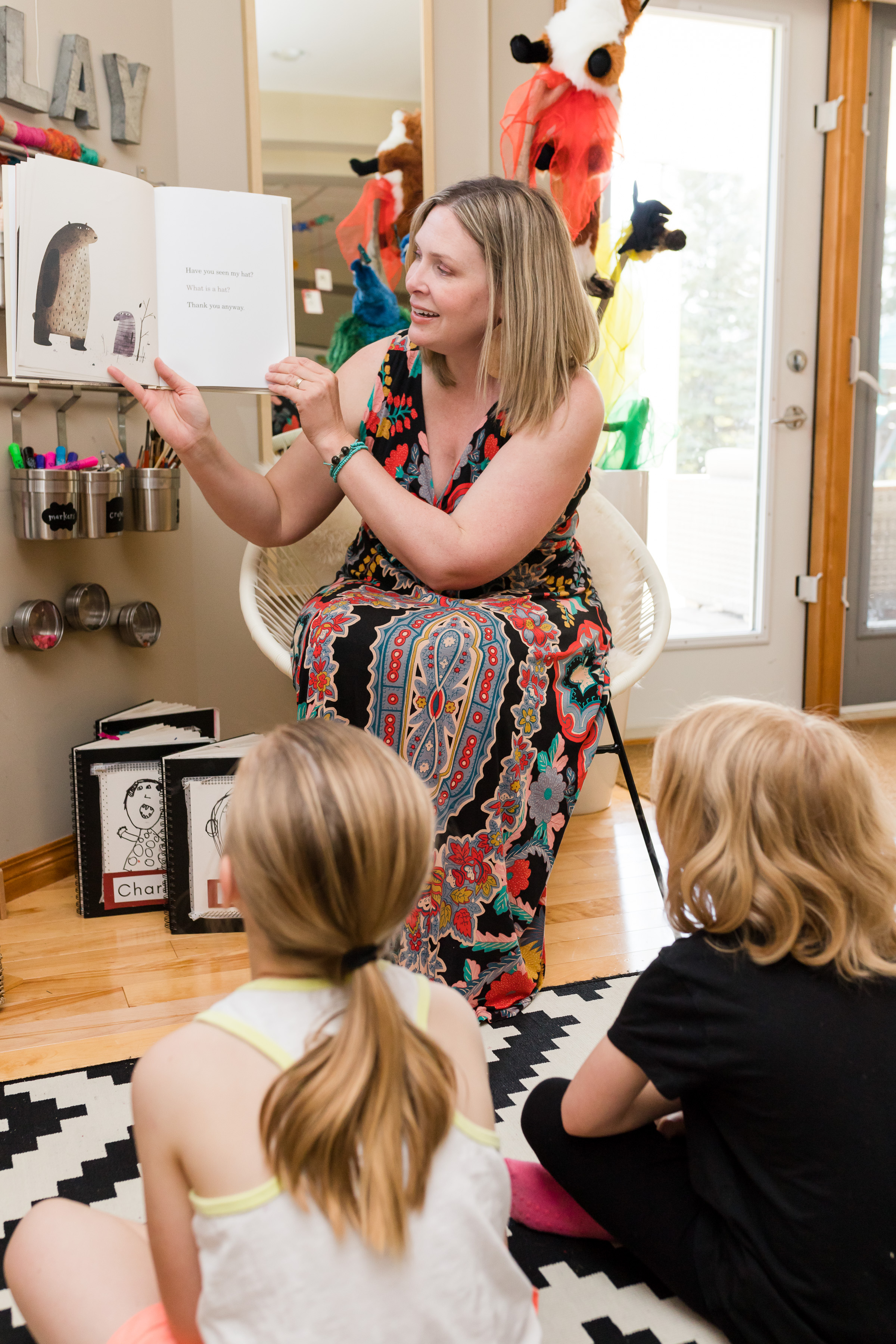Homeschool Morning Meeting: the Play-Based Way
Early years teachers have hosted classroom morning meetings for dozens of years. Morning meetings are an opportunity to come together, share, hear stories and connect through fun rhymes, songs, poems and chants.
How might we adapt Morning Meeting in a homeschool environment? How do we keep it fun and engaging, and keep learning intentional?

When I homeschooled our youngest, I had two other children from the neighborhood who came every other day to learn with us. Each day, we met for 15-20 minutes to explore a few rhythms. This helped to take the guesswork out of planning our days, and provided a structure and rhythm for our day that became predictable. Children do best when they can depend on a predictable schedule - their brains feel safe and optimized for learning.
1. Daily Sign In
We begin each day by signing in. I offered a template for each child to print their name, and share how they were feeling.
This ritual serves a few purposes:
- They are practicing printing their name daily = automaticity and name recognition
- They are identifying and naming their feelings - offering an opportunity for dialogue to share about their emotions and experiences leading up to those emotions.
Members of Artful Teaching. Joyful Learning.® All-in-One Curriculum receive a "Morning Menu" full of daily rhythms including weather, calendar skills and more.
2. Morning Message
Next, we move into our morning message - a daily letter written to the child with a different literacy focus each day.
The literacy strategies practiced inside morning message are intentional and serve as mini-reading lessons. These daily games and tried and true strategies have been borrowed lovingly from my first cooperating teacher, Janet Nein, back when I did my student teaching circa 2000!

We use big chart paper, but this can be done on a plain piece of paper and clipboard, or chalkboard/whiteboard. Inviting your child to “be the teacher” is a way to foster ownership and responsibility over their learning. Giving them a special marker or writing tool, and allowing them to “fix” the message is a great way to empower their sense of agency.
Being intentional about the literacy focus - and explaining the purpose to your child - helps them grow as readers, because we are identifying certain strategies needed to decode words when reading.
For families with multiple ages of children, these strategies can be adapted and modified to meet the needs of each child. Examples to follow.
Monday: Word Detectives (leave out beginning or ending sounds of words)
This strategy encourages children to use their letter-sound knowledge to fill in the missing letter. This is a phonics strategy and is one way that a child uses to decode unknown words when reading.
Adaptations
Younger child: Scavenger hunt post-its for letters in their name. Match the letters with those on the chart.
Older child: Leave out entire words - this is called the Cloze Strategy. Cloze teaches the child to use context and meaning cues within a sentence to determine what word fits or makes sense.
Tuesday: Inside Story (finding small words hiding inside bigger words)
This strategy is called “chunky monkey” and encourages a child to find smaller words that may help him decode the larger word. It also reinforces sight word knowledge, as many times there are smaller sight words embedded inside bigger words. For example: “I see OR inside the word morning.”
Adaptations
Younger Child: Have familiar words with pictures on handmade posters or lists around the chart. dog, cat, mom, dad etc. that he may choose from
Older Child: Once a word is identified, challenge him to write the word family. For example "at" = cat, rat, bat, mat, flat, chat...
Wednesday: Transformers (making words)
This strategy reinforces spelling and sight word knowledge. Invite you child to read the message with you, then “borrow” letters from the chart to spell new words. You might encourage the spelling of familiar words (mom, dad, cat, dog, and different sight words: the, is, an, on.
Adaptations
Younger Child: Have familiar words with pictures on handmade posters or lists around the chart. dog, cat, mom, dad etc. that he may choose from
Older Child: Try to use up ALL the letters in the message to form new words. Try new vocabulary words, words he has been challenged with in his writing etc.
Thursday: C.O.P.S. Capitalization, Omissions, Punctuation, Spelling
This strategy teaches your child the process of editing. Invite your child to “fix” the message by correcting the mistakes. To make it even more authentic, take a passage out of their Writer’s Notebook and invite them to edit it. Work on it together, so you are scaffolding the process.
Adaptations
Younger Child: Keep things simple by focusing on ONE mistake (capital letters)
Older Child: Use passages from their Writer's Notebook, and have them edit their own work.
Friday: Ladybug (kid-friendly take on Hangman)
I use the title of the read-aloud as the mystery message on Fridays. Whatever the book we’ll be reading, I use place-holder spaces for the title for the child to guess. Again, the child is using his understanding of letter-sound correspondence, as well as meaning cues “What makes sense here?”
Adaptations
Younger Child: Give a clue about the title of the book/message "It's an animal" etc.
3. Poem, Song, Chant, Fingerplay
Once morning message is complete, we get ourselves moving with a simple poem, song, chant or fingerplay.

Our children are built to move, so try to weave in lots of opportunities to wiggle, shake, dance and sing - this keeps minds sharp, and kids engaged. I love to use puppets, dolls, scarves and props for this part of our day. Kids LOVE to use props!
Research shows that phonemic awareness is one of the key predictors to reading success. The ability to play with words - rhyme, take apart, stretch, and get willy with words - are the foundational building blocks for literacy. (Lyon, 1995; Smith, Simmons, & Kame'enui, 1998; Shaywitz, 2003)
I love connecting our poems and songs to the topic we’ll be uncovering that day. Many are available on YouTube, and children get a kick out of participating alongside these songs. Emphasize rhyming, syllabication (clapping or stomping to the beat of the poem/syllables of the words), sound substitution (Willoughby Wallaby Woo by Raffi) and tongue twisters.
4. Read Aloud
Next is my favorite time for Morning Meeting - the Read Aloud.

Choosing high-quality children’s literacy is key. Choose books you yourself enjoy. Here are a few criteria when selecting books for your read-aloud:
- Does the book have a rich, juicy plot?
- Are the illustrations captivating?
- Are characters and storyline relatable?
- Is this a book YOU enjoy reading?
Most of the time, I select books that relate to our investigations throughout the day. It’s great to offer a rotating basket of library books on a particular theme or subject.
We begin by going on a picture walk throughout the book. After reading the title, I ask “What do you think this book might be about?” I offer a little background information about the story, and see if the kids can make connections to their own life.
Next, I cover up the text throughout the story, and show a few pages of the book, asking “What do you think is happening in this story?” These connection-building experiences foster our child’s prior knowledge - an important piece of the reading puzzle. When children are able to connect the written word with their own previous experience, they are able to make reading more personal and are much much more likely to understanding and remember what they’ve read (comprehension). (Alexander, Kulikowich, & Schulze, 1994; Shapiro, 2004)
Morning Meeting is a beautiful rhythm to start your day, allowing for a beautiful and predictable way to connect with your child daily. It sets a tone for the day, is low-stress and low-prep, and teaches so many important literacy skills in a short amount of time. Do you have a Morning Time Rhythm you can share? Let me know in the comments!
Interested in adding more structure and organization to your day? Need a solid plan for your upcoming homeschool year? The waitlist will soon be open for: Artful Teaching. Joyful Learning.® All-in-One, K-1 Curriculum!



